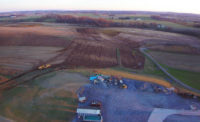Michael Angelo’s emphasizes fresh, quality ingredients to be a leader in the high-end frozen meals category
Finding flavor in the freezer.

Michael Renna and his 132,000-square-foot “kitchen,” located just outside of Austin, Texas.


Even though Michael Angelo’s utilizes automation wherever possible, assembling products like eggplant parmesan or lasagna still requires hand-layering to ensure the product is made correctly.



When it comes to looking at new equipment, Michael is not hesitant to request modifications to make sure that the equipment fits the Michael Angelo’s process. That doesn’t necessarily mean “make it faster,” either.






When choosing a frozen meal, many people assume that it’s not going to taste as good as a home cooked one. It’s something convenient to throw in the microwave at work when there’s no time for anything else. Certainly, it’s not something that can be enjoyed while sitting around the kitchen table at a family dinner.
That perception is being challenged by food companies that are determined to redefine the frozen foods category. These companies are prioritizing healthier ingredients and better taste over a cheaper price point, and it’s becoming increasingly common for consumers to enjoy a gourmet meal at home with their microwave or ovenas the only cooking device. One of the leaders of this category is Michael Angelo’s Gourmet Foods, which has been providing quality frozen Italian meals for more than 30 years. Many of the cherished recipes came from the kitchen of an Italian grandmother in The Bronx. It doesn’t get much more authentic than that.
“Frozen food is all about saving time,” says Michael Angelo Renna, founder and CEO of the company, which now has its headquarters in Austin, Texas. “Everyone talks about frozen foods and the perception of frozen meals. Some of it is earned, and some is just because you’re in that section of the supermarket. But we are changing the perception.”
His mother, Sara, learned how to cook from her grandmother, who came from the Italian island of Sicily. When Sara had children of her own, she would prepare those same recipes, oftentimes preparing a week’s worth of meals in a day so her children could eat well during the week while she worked. In a sense, then, the very first customers of Michael Angelo’s were the Renna children.
“They always had home-cooked meals,” Sara states. “Hot dogs and beans were not in their vocabulary!”
“We were always the house that everybody in the neighborhood came to for dinner,” Michael adds, “and they always told my mom the same thing: ‘You should open up a restaurant.’ Little did we know that’s like a curse as much as it’s a compliment!”
The family’s attempt at a restaurant didn’t become a success, but it did propel them into the world of frozen prepared meals. That business became an incredible success, and Michael Angelo’s has been gracing tables with authentic Italian meals from the freezer since 1982.
Preservative free before it was cool
When Michael Angelo’s started putting its frozen meals into grocery store freezers — first in California and now nationwide — the company used fresh ingredients, with no preservatives. It’s a tradition that the company continues to this day. It wasn’t trying to be a trend-setter; it was just the way that Michael’s mom family always prepared the family meals.
“Taste, texture, all those things were the first consideration,” says Sara, who is semi-retired but still involved heavily in quality control and recipe development. She helped take the family recipes and translate them to a mass production environment without compromising on the quality or the taste. “The bigger the pot, I just made adjustments accordingly.”
The family’s quest to run an Italian restaurant took them from the Bronx to the San Diego area in southern California. While the food was excellent, the restaurant never gained an audience – Michael jokes that the Pac-Man arcade game in the front of the restaurant would gross more than the restaurant on some nights – but the family started producing Italian meals after hours and putting them in freezers. Customers could come in and order a pizza as well as take home eggplant parmesan, lasagna or some other frozen entrée. Eventually, the family started selling them to local retailers.
The Rennas used a retail sampling program to help market their products, as well as convince dubious customers that frozen Italian food could be good quality. Michael recalls one woman in particular who refused repeated attempts to try an eggplant parmesan sample until she finally gave in.
“She came back to the sample table and said, ‘That’s frozen food? Put two of those in my cart and don’t tell anybody I bought these.’” he recalls. “The next week she showed up again, and her comment was, ‘I took two of these and put them in my own casserole dish because I make eggplant parmesan all the time. I fed it to my husband, and he said it was one of the better ones he’s had in a while.’”
Michael Angelo’s reputation began spreading, and the company eventually moved from San Diego to its current headquarters of Austin in order to accommodate customers on both coasts. The company has been located there for 21 years, and don’t call its headquarters a processing plant or a factory.
“We use it as a kitchen, like you have at home. Ours is just bigger.” Michael says.
During the process that took the Renna family from restauranteurs to frozen food makers, they have learned about packaging, marketing and all the other necessary topics. Today, Michael laughs about how naïve they were at the start. They had to learn how to mark up their products appropriately so that the grocer made a profit. They had to learn about USDA regulations after being asked by a retailer why their meat lasagna didn’t have a USDA establishment number.
The one thing they never learned was how to cheapen the product to improve its profits. Items like tomatoes and garlic are purchased not for their price but for their quality. Its parmesan cheese is imported from Parma, Italy. The beef for its organic lasagna is grass-fed, and the company grinds its own meat to ensure maximum freshness and maintain better control over the product. As a result of its quality controls and a steadfast refusal to take shortcuts, the price of its frozen meals is higher than its competitors. However, its customers have supported those efforts with strong sales.
“It was the culinary experience that was first and foremost,” Michael explains. “It’s about that experience on the table for each of the consumers who buy our products and serve their families. That’s the guiding light that we’ve always had.
“At the beginning, we were always told, ‘You’ll never be able to keep the product right. You’ll never, you’ll never.’ I love it when someone says you can’t do something, because that gives you a challenge to make it happen.”
When it came time to recreate the Renna family’s recipes for a mass production environment, Sara prepared multiple batches of products to find the right recipe. Of course, as a chef, she would regularly add spices and seasonings to taste, not to measure, so Michael jokes that he had to grab her hand several times in order to measure the amount and create a recipe that could be followed. She is still the voice of authority for recipes.
“When you go through all the different larger batches, it still comes back to, ‘Does it still taste right?’ We’ll taste it and send it to Ma to see if the quality still tastes right and we didn’t miss anything,” Michael says.
With an emphasis on freshness, it comes as no surprise that the company also employs a JIT (just-in-time) philosophy to its production process. None of the primary ingredients stay in the company’s kitchen for more than a day or two at the most, so the meals can be prepared fresh before they go into the freezers. Today, a lean, JIT manufacturing process is a desirable manufacturing process, but when Michael Angelo’s initially implemented it, the idea was to get the food out to the supermarkets as quickly as possible to get paid as quickly as possible.
“I like to say that if it has wheels, then it’s good inventory. The moment it stops, it’s bad inventory.” Michael says, pointing out that ingredients roll in on trucks, get transferred to rolling racks, which are rolled out to the production floor to be added to the meals. The meals then roll through the production floor on conveyors as they are prepared and packaged, and the finished product rolls onto trucks to be shipped out to grocery stores.
Maintaining relationships
Michael Renna has found himself in some interesting places for the sake of finding the best ingredients possible. He’s walked through fields to find the best tomatoes, worked on a lobster boat to learn about seafood sustainability, and spoken with ranchers about the benefits of grass-fed beef. He admits that at first he didn’t understand the difference between grass-fed beef and the conventional product, but now when he talks to potential beef suppliers, he can impress them by asking about the type of grass that the cattle eat, since each type of plant can affect the taste and texture of the meat.
Not only has he built up his knowledge base, but Michael also has built relationships with suppliers by visiting them and learning first-hand about their business.
“As with anything else, there are going to be challenges that come up, and if you know the person, you can make a phone call,” he explains. “But you’ve got to have that relationship and the experience.”
Michael Angelo’s is one of the country’s largest purchasers of eggplants, and if a freak storm damages the crop, he is in frequent communication with his suppliers as they look elsewhere to meet demand. On the protein side, the company uses antibiotic-free chicken in many of its entrées, as well as the grass-fed beef. It can be difficult to find suppliers that can meet the needs, but Michael Angelo’s has been willing to work with small suppliers as they build up their herd or their crop. Establishing good relationships with its suppliers helps to navigate through those situations easier.
“We started from scratch. I’m of the opinion that if you get good people to work with, you can work with them over time,” Michael says. “It’s a partnership. Sometimes they’re not interested in the risk, and that’s fine.”
Michael Angelo’s “kitchen” is an impressive 132,000 square feet in size and has about 370 employees. The company has adapted to new technology wherever possible, but much of the work is done by hand. The company’s lasagna, for example, is assembled with a long production line where automatic sauce and ricotta cheese depositors alternate with employees laying down layers of noodles.
When it comes to looking at new equipment, Michael is not hesitant to request modifications to make sure that the equipment fits the Michael Angelo’s process. That doesn’t necessarily mean “make it faster,” either. The quality of the end product is more important than line speeds, so equipment that can improve consistency, for example, is more valuable to the company than something that could speed up production — especially if it requires wholesale changes to the production to accommodate the machine.
“We’re not going to modify everything we do to meet the equipment,” he says. “We’ve had depositor modification, cooking vessel modification, everything you can think of. We don’t care what they do to get it there, but we’re going to make sure that what comes out of it fits our needs.”
Michael Angelo’s tried-and-true offerings are still among its top sellers, but the company has continued to release new products and find new partnerships. It has a line of KAMUT® brand organic pasta in four varieties, as well as refrigerated products, which have extended the company’s brand outside of the frozen foods aisle. The freezer case remains its primary destination, and the company’s long-standing dedication to quality should help ensure continued growth as the high-end frozen foods market continues to expand.
“Frozen food is all about saving time,” Michael says, noting that some lesser frozen food options offer the convenience but take away the enjoyment. “Our culinary experience and better-for-you eating experience gives you back that time with the family.”
More companies, from small startups to multinational corporations, are looking at high-end frozen foods as a strong market, and Michael says that there are plenty of other ethnic markets beyond Italian that can benefit from it. Don’t expect that the threat of increased competition will cause Michael Angelo’s to alter its strategy, though.
“The consumers vote with their dollars, and when we started with demoing and sampling, we knew we were doing it right because the customer would come up, taste our meal, and buy our product. That told us to keep doing what we’re doing,” he says.
Looking for a reprint of this article?
From high-res PDFs to custom plaques, order your copy today!












